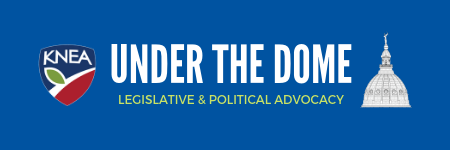The current statute regarding the provisions for working after retirement sunsets on July 1, 2015. This is the second sunset of the law which was originally passed in 2009 and renewed in 2012. During the six years that the current rules for working after retirement have been in place, a number of issues arose and were studied in Legislative Sessions and in Interim Committee Meetings.
During the 2015 Legislative Session both the House and Senate submitted bills to address issues raised by the IRS, by legislators, and by school employees regarding working after retirement. The end product is Senate Substitute for HB 2095, a bill that has now passed both the House and Senate and is awaiting the Governor’s signature.
It is important to understand two pieces of information regarding KNEA and changes to the provisions governing working after retirement.
First, KNEA’s stated position was to simply renew the current provisions for another three years. Representative Ed Trimmer submitted such a proposal in HB 2253 and KNEA testified in favor of the bill.
As legislators discussed issues related to IRS rules and KPERS funding, it became apparent that there were not enough votes in either chamber to support a simple renewal of the current law. The new provisions in Senate Sub for HB 2095 became the “last train out of the station”. If this bill did not pass then the current provisions would sunset and we would return to the previous provisions which set an earnings cap of $20,000 per calendar year while working after retirement in a KPERS-covered position.
The reasons for changing the provisions of working after retirement are quite simple. The IRS had sent a notice letter stating that no pre-arranged hiring agreements could be made between a KPERS eligible employee and the KPERS employers. This system of pre-arrangement was growing in Kansas and if allowed to continue could result in the loss of the tax exempt status of KPERS. Additionally the cost to the KPERS system for employees who worked after retirement was more than the contributions made by the employer to the KPERS system.
Senate Sub for HB 2095 prohibits pre-arranged re-hiring agreements and puts limits on working after retirement. Those limits include:
- Permission to hire a retiree in a hard-to-fill position as determined annually by the State Board of Education. There will be five identified areas statewide.
- Permission to hire a retiree in a hardship position. Such a position is one that has not been designated as hard-to-fill, but for which the school district has been unable to find an applicant. The district must document their efforts to find a non-retiree to fill the position and apply to the Joint Committee on Pensions and Benefits to get permission to use this option. These positions are for one year although they can be renewed.
- Current retirees working after retirement are grandfathered in until July 1, 2017, at which time the new rules will apply to them as well.
The bill also raises the annual earnings cap from $20,000 to $25,000. The cap applies to a calendar year, not a school year.
Given that the only option under consideration was to subject all KPERS retirees to the $20,000 earnings cap, Senate Sub for HB 2095 represents a reasonable compromise. It addresses the problems identified by the IRS and the KPERS actuary, still provides for districts that cannot find new employees to fill positions vacated due to retirements or resignations, and for those who work part time, it raises the earnings cap. KNEA chose not to oppose the final agreement.


